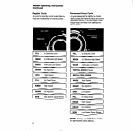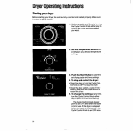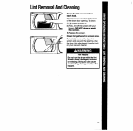
Dryer Operating Instructions
Continued
TIMED DRYING cycle
Use the TIMED DRYING Cycle for any
load you want to dry by time.
l
Turn the Cycle Control Knob to the
number of minutes you want.
l
The last 8 minutes of this cycle
are without heat. This helps make
the load easier to handle.
Using DAMP DRY
Use this setting to dry damp items that
do not require an entire drying cycle, or
to dry items to damp level. (Two exam-
ples are heavy cottons, such as jeans,
which you do not want to become stiff,
or cotton clothes which are easier to
press when damp.)
1.
Set the Cycle Control Knob on
DAMP DRY in the PERMANENT
PRESS Cycle.
2. Push the Start Button.
The dryer tumbles the load with heat
for 22 minutes, then without heat for
8 minutes.
Using TUMBLE PRESS”
The TUMBLE PRESS setting removes
wrinkles from clothing that has been
packed in a suitcase or closet, and from
items not removed from the dryer at the
end of a cycle.
The load will tumble in heated air for
12 minutes. The heat shuts off and the
dryer continues to tumble for 8 minutes.
For best results, put only a few items
at a time in this cycle. As soon as the
dryer stops, put items on hangers or
fold them.
FLUFF AIR cycle
Fire Hazard
Do not dry plastic or rubber items
with heat. Use AIR setting, or line
dry. Failure to do so could result
in fire or damaged items.
The dryer does not heat when the Cycle
Control Knob is set in FLUFF AIR. This
cycle can be used to fluff or air dry bed-
ding, plastic tablecloths, foam rubber
pillows, stuffed toys, sneakers, etc.
1.
Turn the Cycle Control Knob to the
number of minutes you want in
FLUFF AIR.
2. Push the Start Button.
End-of-cycle signal
The dryer sounds a signal to let you
know when the cycle is finished. The
signal cannot be turned off and is
not adjustable.
The signal is helpful when you are
drying permanent press, synthetic and
other items that should be taken out
as soon as the dryer stops.
Gentle Heat system
The dryer automatically reduces the
heat during the last few minutes of each
drying cycle, before cool-down. This
helps prevent overdrying.
16


















